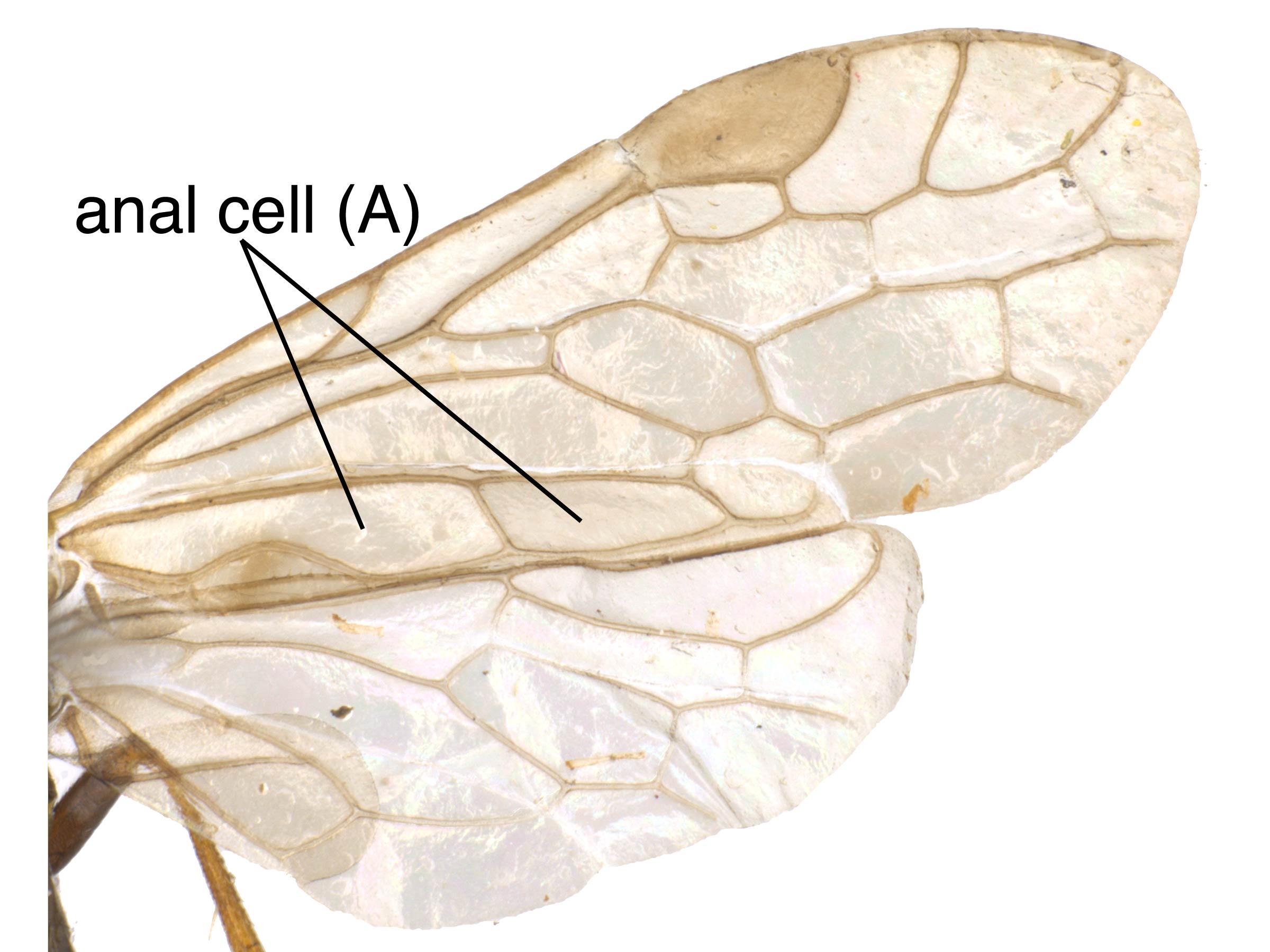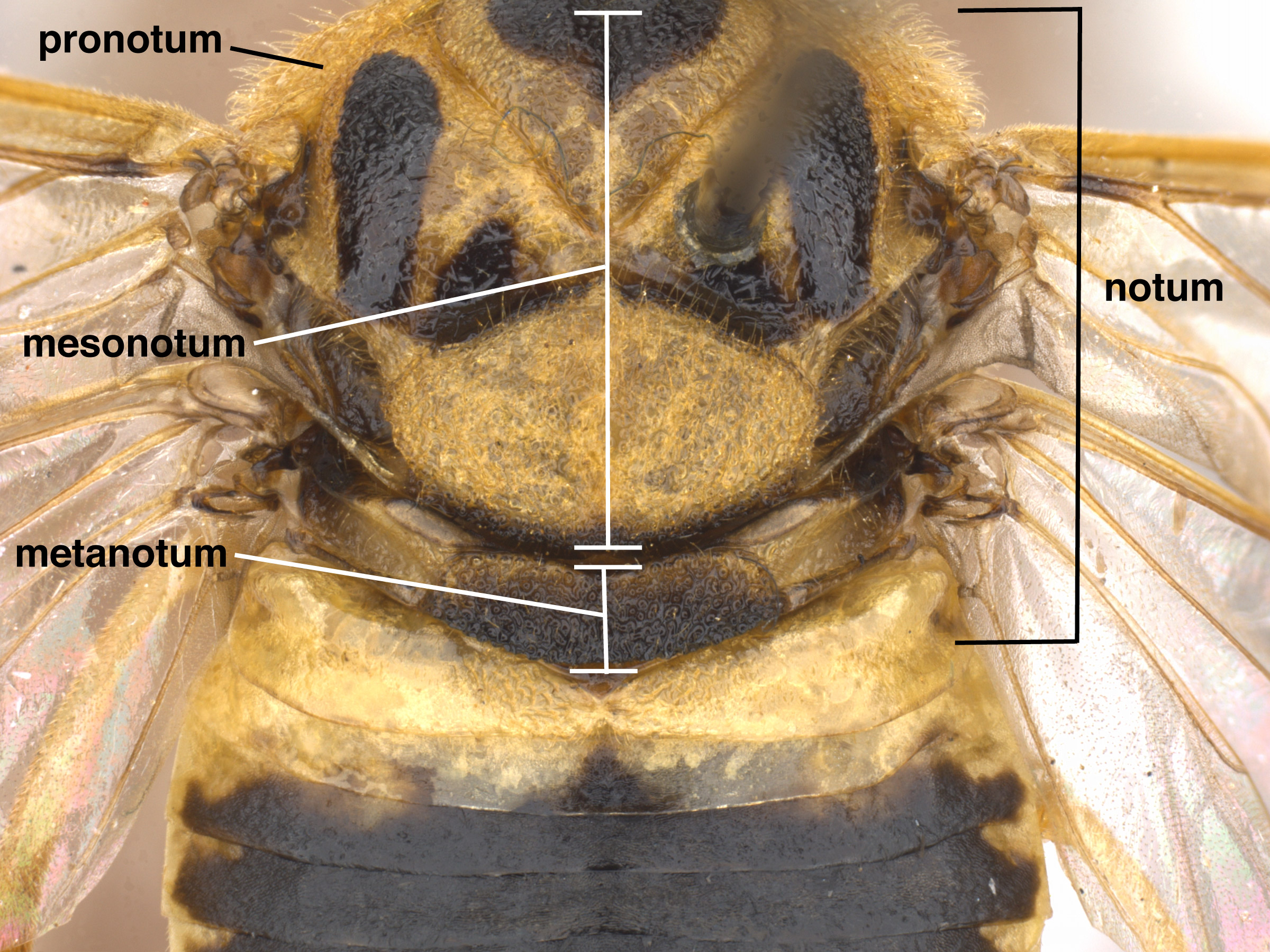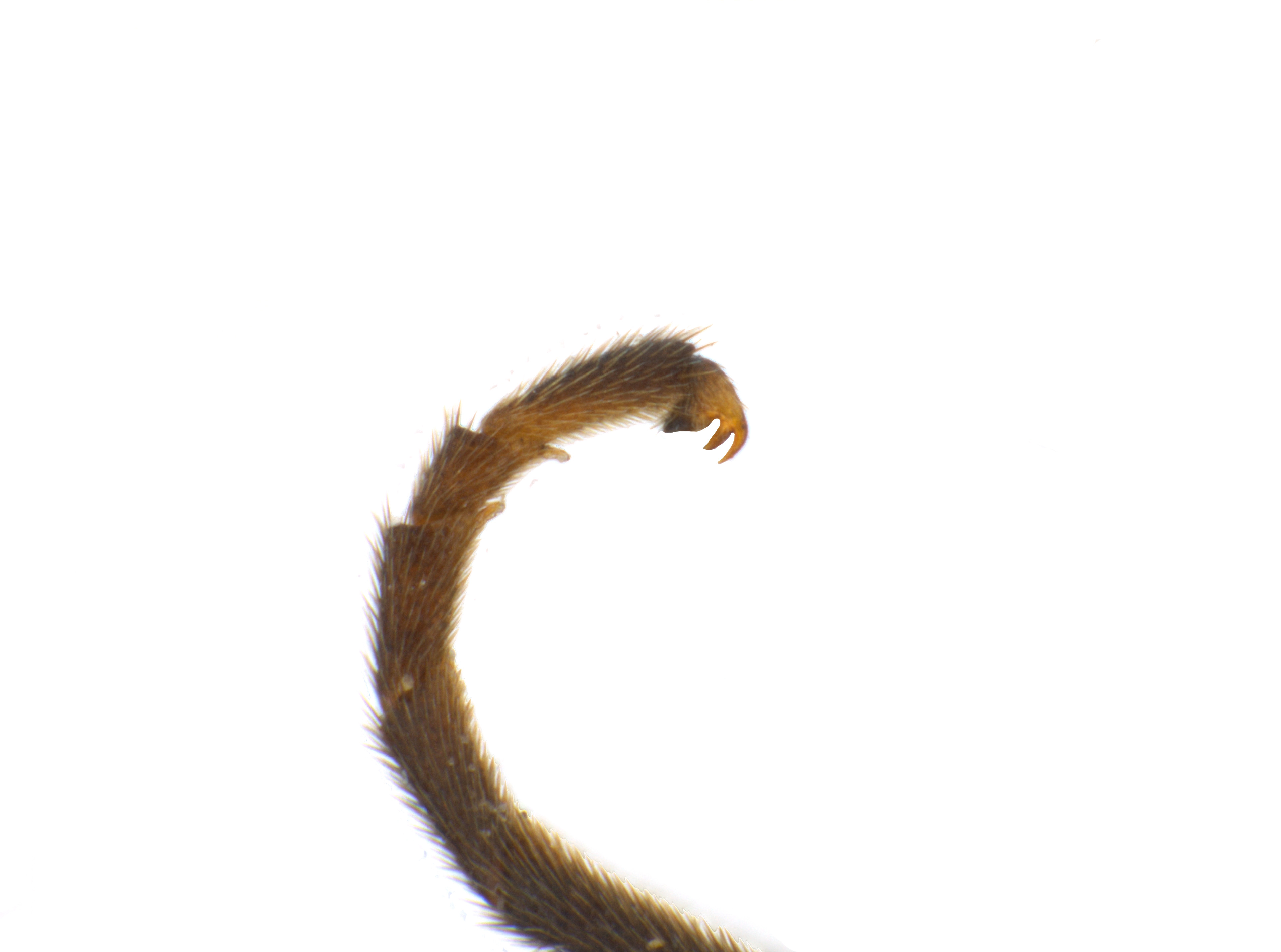Family: Tenthredinidae
Family common name: common sawflies
Subfamily: Heterarthrinae
Tribe: Fenusini
Genus: Metallus Forbes, 1885
Subgenera: none
The Tenthredinidae are the most species-rich family and are found throughout the world, in all continents but Antarctica. They are known as the “common sawflies.” They can generally be recognized by a cylindrical body and long, segmented antennaeantenna:
the sensory organ emerging from the front of the head, usually between the compound eyes and above the clypeus; includes the flagellum, scape and pedicel
 . Otherwise, they come in a variety of colors, sizes, and forms (Goulet 1992Goulet 1992:
. Otherwise, they come in a variety of colors, sizes, and forms (Goulet 1992Goulet 1992:
Goulet H. 1992. The genera and subgenera of the sawflies of Canada and Alaska: Hymenoptera. Symphyta. The insects and arachnids of Canada. Part 20. Agriculture Canada Publication.).
Sawflies in the Heterarthrinae subfamily are generally small and dark-colored. Many species of this family are economic pests of trees and shrubs and can be characterized by their skeletonizing or leaf-mining larval feeding behaviors. Heterarthrinae adults can be distinguished from those of other subfamilies by wing venationvenation:
the network of veins on a wing
(Smith 1971aSmith 1971a:
Smith DR. 1971a. Nearctic Sawflies. III. Heterarthrinae: Adults and larvae (Hymenoptera: Tenthredinidae). Technical Bulletin, U.S. Department of Agriculture 1420: 1-84.).
Metallus are generally small, about 4–5 mm in length, and all black or black and orange (Smith 1971aSmith 1971a:
Smith DR. 1971a. Nearctic Sawflies. III. Heterarthrinae: Adults and larvae (Hymenoptera: Tenthredinidae). Technical Bulletin, U.S. Department of Agriculture 1420: 1-84., Smith 1988Smith 1988:
Smith DR. 1988. A synopsis of the sawflies (Hymenoptera: Symphyta) of America south of the United States: introduction, Xyelidae, Pamphiliidae, Cimbicidae, Diprionidae, Xiphydriidae, Siricidae, Orussidae, Cephidae. Systematic Entomology 13: 205-261.). The Fenusini tribe are all leaf miners (Goulet 1992Goulet 1992:
Goulet H. 1992. The genera and subgenera of the sawflies of Canada and Alaska: Hymenoptera. Symphyta. The insects and arachnids of Canada. Part 20. Agriculture Canada Publication.).
There are 21 described extantextant:
in existence; opposite of extinct
species worldwide. Four species occur in North America (Taeger et al. 2010Taeger et al. 2010:
Taeger A, Blank SM, and Liston AD. 2010. World Catalog of Symphyta (Hymenoptera). Zootaxa 2580: 1-1064.).
A key to NearcticNearctic:
describing the region of the Northern Hemisphere that includes North America south through northern Mexico
 species is included in Smith 1971aSmith 1971a:
species is included in Smith 1971aSmith 1971a:
Smith DR. 1971a. Nearctic Sawflies. III. Heterarthrinae: Adults and larvae (Hymenoptera: Tenthredinidae). Technical Bulletin, U.S. Department of Agriculture 1420: 1-84..
Subfamily characters
 M slightly constricted at apexapex:
M slightly constricted at apexapex: vein 2r present (Goulet 1992Goulet 1992:
vein 2r present (Goulet 1992Goulet 1992:Genus characters
 wider than long (Goulet 1992Goulet 1992:
wider than long (Goulet 1992Goulet 1992: veins 2A and 3A incomplete (Smith 1971aSmith 1971a:
veins 2A and 3A incomplete (Smith 1971aSmith 1971a: anal cellanal cell:
anal cellanal cell: present and petiolatepetiole:
present and petiolatepetiole: cellcell:
cellcell: R1 closed, not open to margin (Smith 1967cSmith 1967c:
R1 closed, not open to margin (Smith 1967cSmith 1967c: with dense, even hairs (Goulet 1992Goulet 1992:
with dense, even hairs (Goulet 1992Goulet 1992: with large basalbasal:
with large basalbasal: bifidbifid:
bifidbifid: ; teeth of claw about equal in length (Smith 1971aSmith 1971a:
; teeth of claw about equal in length (Smith 1971aSmith 1971a:Metallus can be confused with other genera in the subfamily, especially similar genus Fenusella. It can be distinguished by the bifidbifid:
divided or forked into two branches or parts
 tarsal claw, antennal pedicelpedicel:
tarsal claw, antennal pedicelpedicel:
the second antennal segment, between the scape and flagellum
 width, and haired mesonotummesonotum:
width, and haired mesonotummesonotum:
the second segment of the dorsum of the thorax
 (Smith 1967cSmith 1967c:
(Smith 1967cSmith 1967c:
Smith DR. 1967c. A review of the subfamily Heterarthrinae in North America (Hymenoptera: Tenthredinidae). Proceedings of the Entomological Society of Washington 69: 277-284., Goulet 1992Goulet 1992:
Goulet H. 1992. The genera and subgenera of the sawflies of Canada and Alaska: Hymenoptera. Symphyta. The insects and arachnids of Canada. Part 20. Agriculture Canada Publication.). The males have distinctly widened and flattened third and fourth antennal segments (Smith 1971aSmith 1971a:
Smith DR. 1971a. Nearctic Sawflies. III. Heterarthrinae: Adults and larvae (Hymenoptera: Tenthredinidae). Technical Bulletin, U.S. Department of Agriculture 1420: 1-84.).
none
Metallus capitalis and M. rohweri feed on species of Rubus (blackberry, raspberry, etc.), and M. lanceolatus feeds on Geum (avens) (Goulet 1992Goulet 1992:
Goulet H. 1992. The genera and subgenera of the sawflies of Canada and Alaska: Hymenoptera. Symphyta. The insects and arachnids of Canada. Part 20. Agriculture Canada Publication., Eiseman and Smith 2017Eiseman and Smith 2017:
Eiseman CS and Smith DR. 2017. Nearctic Species of Metallus Forbes (Hymenoptera: Tenthredinidae): Biology and Distribution. Proceedings of the Entomological Society of Washington 119(4): 551-564. https://doi.org/10.4289/0013-8797.119.4.551).
Females oviposit into the upper surface of a leaf. After hatching, larvaelarva:
the immature stage of holometabolous insects
 feed on the inner leaf tissue and create blotch mines, which sometimes combine into one because they are not able to establish mines on new leaves. At maturity, the larvaelarva:
feed on the inner leaf tissue and create blotch mines, which sometimes combine into one because they are not able to establish mines on new leaves. At maturity, the larvaelarva:
the immature stage of holometabolous insects
 exit the mines and fall to the soil to build a cellcell:
exit the mines and fall to the soil to build a cellcell:
1. a membranous area of the wing between veins, 2. a small cavity or closed space
 , then burrow and pupate, or overwinter. (Eiseman and Smith 2017Eiseman and Smith 2017:
, then burrow and pupate, or overwinter. (Eiseman and Smith 2017Eiseman and Smith 2017:
Eiseman CS and Smith DR. 2017. Nearctic Species of Metallus Forbes (Hymenoptera: Tenthredinidae): Biology and Distribution. Proceedings of the Entomological Society of Washington 119(4): 551-564. https://doi.org/10.4289/0013-8797.119.4.551). Other Fenusini larvaelarva:
the immature stage of holometabolous insects
 lack larval prolegs, but prolegs are present on Metallus abdominal segments 2–7 and 10 (Smith 1971aSmith 1971a:
lack larval prolegs, but prolegs are present on Metallus abdominal segments 2–7 and 10 (Smith 1971aSmith 1971a:
Smith DR. 1971a. Nearctic Sawflies. III. Heterarthrinae: Adults and larvae (Hymenoptera: Tenthredinidae). Technical Bulletin, U.S. Department of Agriculture 1420: 1-84.). The species native to North America are univoltineunivoltine:
describing an insect with a life cycle of one generation per year
or bivoltinebivoltine:
describing a life cycle with two generations per calendar year
(Eiseman and Smith 2017Eiseman and Smith 2017:
Eiseman CS and Smith DR. 2017. Nearctic Species of Metallus Forbes (Hymenoptera: Tenthredinidae): Biology and Distribution. Proceedings of the Entomological Society of Washington 119(4): 551-564. https://doi.org/10.4289/0013-8797.119.4.551).
One species, M. ochreus, can overwinter as an early instarinstar:
a stage of development between molts in insects; often is a larval stage
larva. This habit has not been recorded in any other leaf-mining or externally leaf-feeding sawfly (Eiseman and Smith 2017Eiseman and Smith 2017:
Eiseman CS and Smith DR. 2017. Nearctic Species of Metallus Forbes (Hymenoptera: Tenthredinidae): Biology and Distribution. Proceedings of the Entomological Society of Washington 119(4): 551-564. https://doi.org/10.4289/0013-8797.119.4.551).
Metallus lanceolatus was introduced from Europe. This potential pest species is multivoltinemultivoltine:
describing a life cycle with many generations per calendar year
(Looney et al. 2016Looney et al. 2016:
Looney C, Smith DR, Collman SJ, Langor DW, and Peterson MA. 2016. Sawflies (Hymenoptera, Symphyta) newly recorded from Washington State. Journal of Hymenoptera Research 49: 129-159. https://doi.org/10.3897/JHR.49.7104, Eiseman and Smith 2017Eiseman and Smith 2017:
Eiseman CS and Smith DR. 2017. Nearctic Species of Metallus Forbes (Hymenoptera: Tenthredinidae): Biology and Distribution. Proceedings of the Entomological Society of Washington 119(4): 551-564. https://doi.org/10.4289/0013-8797.119.4.551).
World: This genus is known from North America, Europe, and Asia, with records as far south as Nepal and Myanmar (Smith 1976bSmith 1976b:
Smith DR. 1976b. World genera of the leaf-mining sawfly tribe Fenusini (Hymenoptera: Tenthredinidae). Insect Systematics and Evolution 7: 253-260., Taeger et al. 2010Taeger et al. 2010:
Taeger A, Blank SM, and Liston AD. 2010. World Catalog of Symphyta (Hymenoptera). Zootaxa 2580: 1-1064.).
North America: Metallus occurs throughout the northern United States and southern Canada, as far south as Oregon in the west, and Virginia in the east (Smith 1971aSmith 1971a:
Smith DR. 1971a. Nearctic Sawflies. III. Heterarthrinae: Adults and larvae (Hymenoptera: Tenthredinidae). Technical Bulletin, U.S. Department of Agriculture 1420: 1-84.). One introduced species, M. lanceolatus, was first collected in British Columbia in 1933, then in several northeastern states and provinces in the 1960s, and is now also recorded from Washington (Looney et al. 2016Looney et al. 2016:
Looney C, Smith DR, Collman SJ, Langor DW, and Peterson MA. 2016. Sawflies (Hymenoptera, Symphyta) newly recorded from Washington State. Journal of Hymenoptera Research 49: 129-159. https://doi.org/10.3897/JHR.49.7104).
Map data from: GBIF.org (29 October 2019) GBIF Occurrence Download Metallus
Details about data used for maps can be found here.